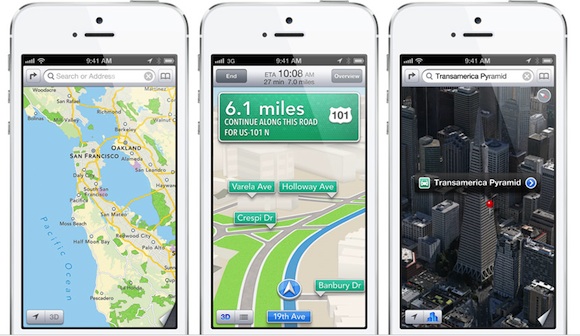 (Credit:
Josh Lowensohn/CNET, PhotoToaster)
(Credit:
Josh Lowensohn/CNET, PhotoToaster)
For those who haven't yet upgraded to Apple's
iOS 6,
or who can't upgrade because they're using an older device, there's an
air of uncertainty about just how long they'll get to be able to use one
of its most useful features.
That feature is maps, something that used to be powered by Google in
iOS versions 1 to 5, but which now uses data from Apple in iOS 6.
Love it or hate it, Apple Maps are here to stay. But can you say the same about the old version?
Neither company is willing to say. An Apple spokesperson declined to
comment on the terms or expiration of the deal between it and Google.
Google did not respond to a request for comment.
Still, there's reason for users to believe that Google will continue
serving the iOS 5 version of maps for the foreseeable future.
"I would be surprised if they have the contractual right to stop," said Scott Rafer, CEO of mapping company Lumatic.
Lumatic is the maker of City Maps, a provider of free transit
directions inside the new Apple Maps app. It licenses data from Nokia
and OpenStreetMap.
"Normally the ways those contracts are written are, hey, this covers
support of new versions of the software through X date," Rafer said,
adding that he had not seen the Apple-Google contract.
Assuming that's the case here, iOS 5 users should be able to rest easy about the mapping functionality on their older devices.
Perhaps backing that up is the fact that Google says it will keep
supporting the old version of YouTube, another piece of Google software
removed in iOS 6. The company confirmed to CNET that it would
continue serving videos inside the app indefinitely. Meanwhile, it has built its own
standalone app for iOS 6 users, which is available on the App Store.
At its annual developers conference in June, Apple touted its new
maps app as one of the major features of iOS 6 -- and a big step up from
Google's offering. But now that they have it in hand, many consumers
beg to differ. While impressive in places,
critics have found the application less accurate and complete compared with Google's offering.
Still, Apple has published data showing that users are upgrading to
its latest software at a very speedy clip. According to metrics
released by the company yesterday, 100 million of Apple's 400 million iOS users
have upgraded to iOS 6. The software, which was
released as a free update last Wednesday, can be installed on the
iPhone 3GS, 4 and 4S, along with the second- and third-generation iPads, and fourth-generation
iPod Touch. That keeps those with older devices -- a number Apple does not share -- on older versions of the software.
One prospect that remains for those who have upgraded is Google
delivering its own Maps app. So far the company has kept an almost
Apple-like veil of secrecy around the project, saying only that its
objective was to make the software "available to everyone who wants to
use it, regardless of device, browser, or operating system."






 Native, ready-to-use UI controls: The SDK includes several pre-built user interface controls:
Native, ready-to-use UI controls: The SDK includes several pre-built user interface controls:


